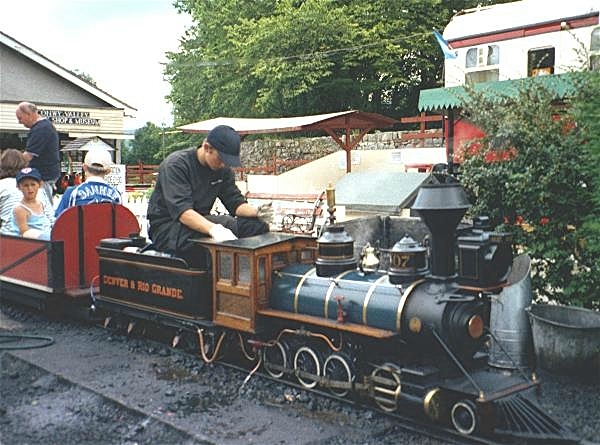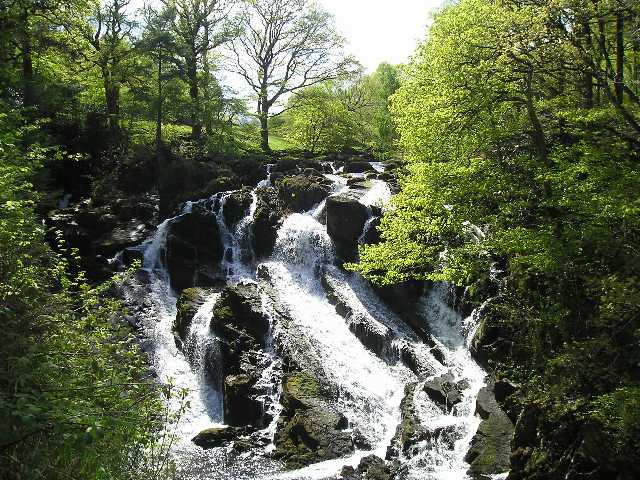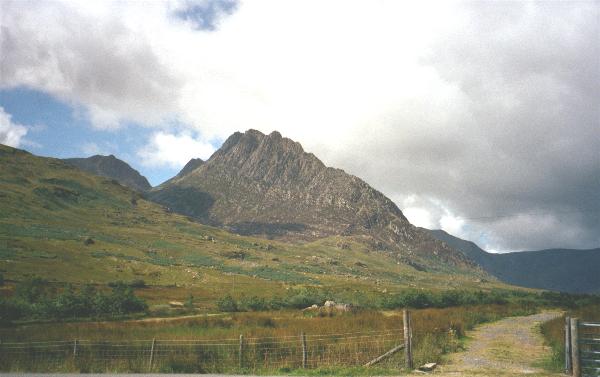[Llandudno HOME] [Pen-y-Pass] [Llanberis Pass] [Bodnant] [Great Orme] [Caernarfon] [Public Transport] [Excursions] [Links]
Through the Conwy & Lledr Valleys
to Blaenau Ffestiniog & Porthmadog
Part
2 - Betws-y-coed [Part 1 - The Conwy
Valley]
[Part 3 - The
Lledr Valley] [Part 4
-
Vale of Ffestiniog]
Betws-y-coed
is a village in the Conwy valley in the county borough of Conwy, North
Wales. It lies in the Snowdonia National Park in the valley
near the point where the River Conwy is joined by the River Llugwy and
the River Lledr. The name Betws-y-coed means Prayer house
in the wood. The village was founded around this little church,
possibly a monastery, in the late sixth century. In 1815,
the Waterloo Bridge built by Thomas Telford to carry A5 road across the
River Conwy and through the village brought considerable development. The
village became an important road junction and coach centre on
Telford's new road from Llangollen and Corwen (in the east) to Capel
Curig and Bangor (in the west) on the Irish Mail route from London to
Holyhead. This led to the improvement of the roads south to Dolwyddelan
and Blaenau Ffestiniog and north to Llanrwst and Conwy.
Braving the cold waters of the Afon Llugwy and enjoying the sun on the falls below Pont-y-Pair,
the bridge at the approach to Betws-y-coed on the B5106 road from Conwy via Trefriw.
A roadside waterfall on the A470 from Llandudno and Llanrwst just before it joins
the A5 from London, Llangollen and Corwen.
The old
coaching inn on the A5 just before its junction with the A470 to
Llanrwst and Llandudno. Before the
erection of the Waterloo Bridge in 1815, the mail coaches had to travel
via
Llanrwst and the B5106 road south from there to Betws-y-coed and
onwards to
Capel Curig and Bangor. This inn on the outskirts of the village is the
first of several coaching inns clustered here at Betws-y-coed on the
famous A5 road.
The bridge in celebration of victory at the battle of Waterloo and built by Telford in cast iron,
one of the earliest such bridges.
The River Conwy looking northwards from the Waterloo Bridge.
Footbridge over the Afon Conwy near the venerable old church of St Michael:
St Michael's and its ancient churchyard, almost certainly the site of the Prayer house in the wood that gives Betws-y-coed its name, are cared for by a local charitable trust. Nearby is the Betws-y-coed railway museum and the station:
The
extensive station buildings built in 1868 at Betws-y-coed on the Conwy
Valley line have been attractively
developed as shops, cafés and restaurants accessed from the
station forecourt and carparks. The main street of Betws-y-coed is
famous for its fine hotels and several excellent Welsh woollen and
tapestry and outdoor sportswear shops. Across the line in the
former goods yards is the Conwy Valley Railway Museum.
The museum has mainline railway exhibits (lunch and tea available in the dining car)
and an extensive miniature railway.
The Museum is reached by this footbridge from the station platform
or from its own carpark near St Michael's Church.

The miniature railway operates a variety of steam and diesel engines and gives adults and children
a delightful ride round the museum and through a wooded park.
The
Betws-y-coed station forecourt is also the starting point
for several bus services including services to Penmachno, Pentrefolas,
Corwen, Llangollen, Dolwyddelan and Blaenau Ffestiniog together with
the famous Sherpa bus services via the
Swallow Falls, Capel Curig and the
Snowdonia mountain passes to Pen-y-Pass,
Beddgelert, Porthmadog, Llanberis,
Caernarfon, Bethesda and Bangor.

The Swallow Falls between Betws-y-coed and Capel Curig.
The Swallow Falls between Betws-y-coed and Capel Curig.
Here
in the
delightful Snowdonia
village of Capel Curig (about four miles from Betws-y-coed), near the
junction of the
Nant Ffrancon and the Pen-y-Gwryd roads is an ancient church Eglwys Santes Julitta
now in the care of a local
charitable trust. In pre-Norman times the dedication of this church was
probably to Saint Curig, a Welsh Bishop of the 6th Century. Later the
name became Latinised to Cyriacus and identified with Saint Cyricus who
with his mother Saint Julitta was martyred at Tarsus c304 AD. Probably
known by the end of the 12th century as Saints Cyricus and Julitta, it
later became known just as Saint Julitta.

Tryfan near Ogwen in the Nant Ffrancon Pass on the A5 road to Bethesda and Bangor.
Photographs © 2004/7 by Noel Walley. Updated January 2009.
Email: Webmaster
Conwy & North Wales